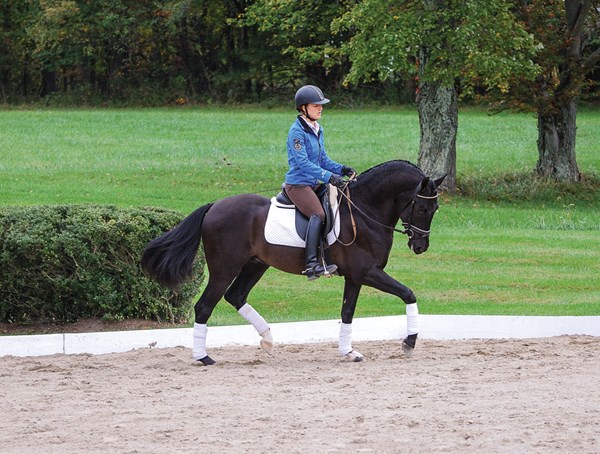
In this photo, Wendy Malek is showing her 9-year-old mare, Bella, in First Level. She wrote that she and her horse have little experience, as Bella was ridden for half a year as a 4-year-old and started back into work about six months ago. Wendy herself only started to ride dressage a few years ago and said they were “trying” First Level at this show.
From this photo, Bella clearly looks fit for First Level. Her outline and frame in the trot look correct and nice. Instead of saying that they are “trying” First Level, Wendy should proudly state: “We are showing First Level.”
I am stressing this because in a dressage arena there is no room for “trying” or “maybe.” In training a horse you must attempt to make things black and white because horses can sense if the rider is not sure of herself and will react to this.
I once had a trainer tell me: “If you stop riding politely, your horse will stop moving politely.” He was commenting on how I always thought that maybe we were not good enough or fit enough to do something and, as a result, I kept holding my mare back.
So just remember, if you decide to show First Level, then there is no question about trying—you go out and show your abilities.
Showing is always exciting, especially when a rider and a horse do not yet have a lot of common experience. In this photo, Wendy looks more excited than Bella. Her mare is showing a supple and fluid movement with a nice open topline. There is a soft contact to the bit in an outline that is very pleasing to see at this level.
Looking at Wendy, I first wanted to tell her to breathe out. She looks as if she took a huge breath before starting the test, hoping the air would last until they were done. The tension in her face, shoulders and upper-body position signal this.
The outline of her seat (I presume she is posting the trot ) is correct, but she appears a bit tense. Her inside hand is a bit back and closer to her body than her outside hand. This can lead to shortening the inner side of her upper body as a result of bending at her waist.
Not breathing properly has a huge impact on any form of physical activity. In long-distance running, athletes count how many steps they breathe out and in and compare this to their fitness. For example, they count to five while exhaling and then count to three while inhaling. Only in a final sprint would they start to breathe in a one-to-one ratio.
Try this: Translate this to riding by counting how often you post in rising trot compared to how often you inhale. Repeat this, but count how often you post for every exhale. Make sure the number of posts per inhale and exhale is at least even. If possible, try to post more during each exhale.
This will guarantee a better oxygen saturation in your whole body and better muscle effectiveness. A lack of oxygen in the body causes weakened coordination and then the muscle loses strength. In riding, this coordination is more important than strength. Otherwise, all riders compete against each other with success.
Watching Wendy’s face, I get the impression that she is trying to keep the smile on or that she is clenching her teeth. Either is not working together with deep, relaxed breathing.
Try this: Clench your teeth and try to breath deeply. This is not easy because this causes shallow breathing that takes place in the upper areas of the lungs and is executed by muscles that are attached around the shoulders and neck. To avoid this tight jaw, chew imaginary gum.
This tension around the shoulders that is visible in Wendy’s position may only be a result of her breathing. With a little more confidence in her own riding, that will disappear. Less tension in her shoulders will also be key for her to correct her inside hand position.
Bella is looking happy in her work and she is sure to develop with more steady and regular training.
Susanne von Dietzeis a leader in equestrian biomechanics. A physiotherapist, licensed Trainer A instructor and judge for dressage and show jumping, she gives lectures and seminars throughout the world, including at the prestigious German Riding Academy in Warendorf. She is a native of Germany and now lives with her husband and three children in Israel, where she competes at the international level. She is the author of two books on the biomechanics of riding: Balance in Movement and Horse and Rider, Back to Back. Find her books at HorseBooksEtc.com.











